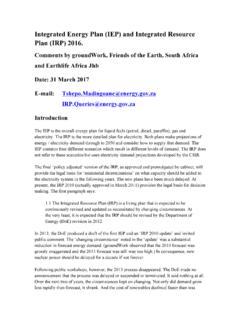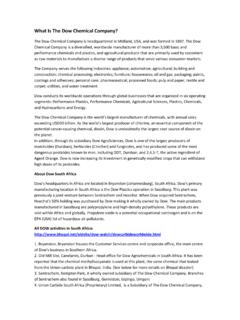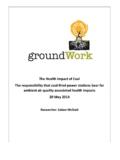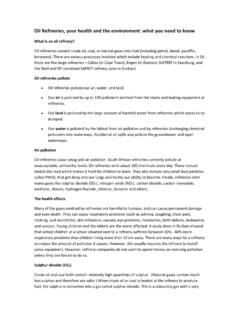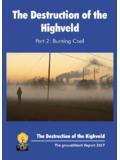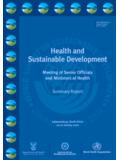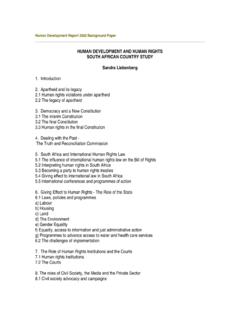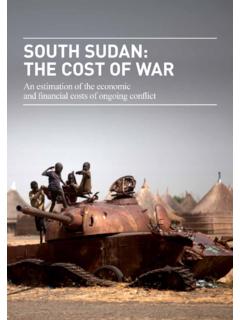Transcription of Solidarity for Environmental Justice in Southern …
1 1 Solidarity for Environmental Justice in Southern africa By Victor Munnik, independent researcher, A report for groundWork, November 2007 Contents: Solidarity for Environmental Justice in Southern Introduction and overview ..2 Environmental Justice ..2 Southern African activists embrace Environmental Justice Mechanisms that produce Environmental Southern africa ..5 Regional Minerals Energy Political DRC: State of war over natural Industrialisation and New scramble for africa ..9 Platinum boom pushes people off their Artisanal diamond miners: modern day slaves.
2 10 Rich copper grades and poor communities ..11 Energy at all costs ..13 Nukes for Big dams displace Aluminium smelters: starved for Timber extraction and Ongoing illegal timber extraction in People s forests Plantations are not forests ..16 Polluted water ..17 What is to be done? ..17 Logic of Environmental Justice struggles ..18 Self-defence in a democratic space ..19 Building in Conclusion ..21 Bibliography ..21 Environmental Justice obtains where relations between people, within and between groups of people, and between people and their environments are fair and equal, allowing all to define and achieve their aspirations without imposing unfair, excessive or irreparable burdens or externalities on others or their environments, now and in the future.
3 GroundWork Report 2004, The Balance of Rights, Hallowes and Butler 2 Introduction and overview This position paper is an invitation to build stronger Solidarity in support of Environmental Justice in Southern africa . The immediate reason is that our communities and activists are faced with a commodity boom - a new scramble for africa . The new scramble, like the old, is driven by the interests of outside powers, the traditional players now joined by China, India and Brazil, in the resources of africa . These interests are being accommodated by African governments, who themselves are taking part in the scramble, while the legacies of previous rounds of accumulation and their effects on people s environments have not yet been cleaned up and are unlikely ever to be cleaned up.
4 The balance of political power in all of our societies, while dynamic and subject to ongoing change, suggests that Southern africa will face increasing Environmental injustice in the way its resources are used, including the ongoing enclosure of people s commonly owned and used resources into private domains, the unequal and unfair relationships between local populations, national decision makers and private investors, the ongoing exclusion from decision making of local communities, and the intensifying imposition of externalities. Current developments, specifically the commodities boom and the rapid expansion of South African business and industry into the region, make it increasingly less feasible for Environmental Justice activists in the region to continue working in isolation in our respective countries.
5 Southern africa is already a single unit, and increasingly EJ activists face the same polluting companies and similar issues in different settings in the region. This paper explores the idea of Environmental Justice in Southern africa , in the context of the region s history and current challenges. Environmental Justice The concept of Environmental Justice first evolved among black communities in the United States, and at a very local level. Southern African activists embrace Environmental Justice concept In the 1980s, black Americans observed that their communities were always the first to be the recipients of toxic waste dumps and other dangerous developments, and called it Environmental racism.
6 The movement was grounded in local resistance to pollution, and the 1982 Warren County fight against toxins stands as an important landmark [Munnik and Cock, forthcoming]. These activists also protested against the conservation-oriented and white, middle class dominated character of the US mainstream Environmental movement. These two orientations a local emphasis with a questioning of the national politics within which the resistance takes place remain cornerstones of Environmental Justice thinking today. By 1991, the First National People of Color Environmental Leadership Summit in Washington agreed on the principles of Environmental Justice .
7 According to one of the leading figures, Robert Bullard, the meeting broadened the Environmental Justice movement beyond its anti-toxics focus to include issues of public health, worker safety, land use, transportation, housing, resource allocation and community empowerment [Bullard, quoted in Khan, 1996: 27]. This is a third trend that remains part of the legacy of Environmental Justice : a tendency to include a broad range of issues into Environmental Justice , because the starting point of Environmental Justice is people and their rights in their environments, and not the environment in an abstract sense.
8 3 In 1992, the concept of Environmental Justice (EJ) was imported to South africa at the Earthlife africa conference where the Environmental Justice Network Forum (EJNF) was established. At the conference US inner city activist Dana Alston introduced it as a very broad issue extending existing social Justice or human rights work: Environment Justice affords us a platform to address some of the critical issues of our time. She also opened another theme with which Environmental Justice activists have to deal when confronted with development schemes: Private industry has exploited the pervasive unemployment among people of colour.
9 They have promoted the idea that poor people must choose between jobs and a clean Over the last thirty years, our communities have been desperate for development and have accepted polluting industries. We were told we would receive jobs, that an expanded tax base could be used to address community needs and development, and that our health would be protected. In reality, the few jobs that we did get were the lower-paying and more hazardous jobs. [Alston, 1993: 188] For South Africans, seeing Environmental Justice as an extension of anti-apartheid struggle was as natural as for black communities and activists in the US to proceed from the basis of the civil rights struggle.
10 The Environmental Justice movement similarly grew in South africa as an alternative to the narrow conservation movement and its Big Five focus, not as an outgrowth of it. EJ activists positioned themselves in opposition to many forms of conservation as they supported black South Africans in their efforts to claim back land that they had lost to conservation. Apartheid presented clear forms of Environmental injustice control over movement, resettlement on the worst land, second class services, if any and the almost automatic location of waste dumps near black communities mirrored the US experience.
